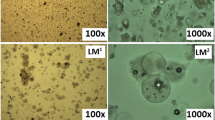Abstract
Glycaemic impact is an important health-related property of foods which may be controlled by regulating glycaemic carbohydrate release during digestion. Equations were derived for designing surface-digested particles of defined glycaemic impact. They related the proportion (P) of a particle digested after T minutes of digestion to the initial particle diameter (D 0 millimetres) and the mean rate of superficial volume erosion (E cubic millimetres per minute):
-
(a)
Spherical particles:
-
(b)
Cylindrical particles of initial length L 0:
-
(c)
Flat structures of depth D, length L 0 and width W 0
Using spreadsheets based on the equations, erosion rate was continuously adjusted from its initial value in response to non-linear and progressive reduction in particle surface area during digestion. Then, for a given digestibility, the particle dimensions required to deliver the time-dependent proportions of nutritionally distinct carbohydrate fractions, rapidly digested, slowly digested and inaccessible digestible starch, could be determined. The results were confirmed by in vitro digestion. The glycaemic impact of starch may potentially be manipulated using the relationship between time, digestibility and particle dimensions, by delivering it in the form of solid food particles whose rates of digestion depend on surface area predetermined by their geometry.







Similar content being viewed by others
References
Brand-Miller JC, Holt SHA, Pawlak DB, McMillan J (2002) Glycaemic index and obesity. Am J Clin Nutr 76:281S–285S
Brand-Miller JC, Stockman K, Atkinson F, Petocz P, Denyer G (2009) Glycemic index, postprandial glycemia, and the shape of the curve in healthy subjects: analysis of a database of more than 1000 foods. Amer J Clin Nutr 89:97–105
Brighenti F, Pellegrini N, Casiraghi MC, Testolin G (1995) In vitro studies to predict physiological effects of dietary fibre. Eur J Clin Nutr 49:S81–S88
Brooks S, Craig S, DeVries J, Brooks S, Higgins J, Jones J, Li B, Lineback D, Monro J, Poutanen K (2006) Report of the ad hoc Glycemic (Net) Carbohydrate Definition Committee to AACC International Board of Directors. http://www.aaccnet.org/membership/pdfs/glycemicreport0906.pdf. Accessed 4 Mar 2011
Brownlee M (2001) Biochemistry and molecular biology of diabetic complications. Nature 414:813–820
Guigliano D, Ceriello A, Esposito K (2008) Glucose metabolism and hyperglycemia. Amer J Clin Nutr 87:217S–222S
Englyst HN, Hudson GJ (1987) Colorimetric method for routine analysis of dietary fibre as non-starch polysaccharides. A comparison with gas-liquid chromatography. Food Chem 24:63–76
Englyst KN, Englyst HN, Hudson GJ, Cole TJ, Cummings JH (1999) Rapidly available glucose in foods: an in vitro measurement that reflects the glycemic response. Am J Clin Nutr 69:448–454
Evans DF, Pye G, Bramley R, Clarke AG, Dyson TJ, Hardcastle JD (1988) Measurement of gastrointestinal pH profiles in normal ambulant humans. Gut 29:1035–1041
Fardet A, Leenhardt F, Lioger D, Scalbert A, Rémésy C (2006) Parameters controlling the glycaemic response to breads. Nutr Res Rev 19:18–25
Germaine KA, Samman S, Fryirs CG, Griffiths PJ, Johnson SK, Quail KJ (2008) Comparison of in vitro starch digestibility methods for predicting the glycaemic index of grain foods. J Sci Food Agric 88:652–658
Goni I, Garcia-Alonso A, Saura-Calixto F (1997) A starch hydrolysis procedure to estimate glycemic index. Nutr Res 17:427–437
Granfeldt Y, Bjork I (1991) Glycemic response to starch in pasta: a study of mechanisms of limited enzyme availability. J Cereal Sci 14:47–61
Guyton AC, Hall JE (2000) Textbook of Medical Physiology, 10th edn. WB Saunders, Philadelphia
Howarth NC, Saltzman E, Roberts SB (2001) Dietary fibre and weight regulation. Nutr Rev 59:129–139
Jenkins DJA, Wolever TMS, Taylor RH (1980) Rate of digestion of foods and post-prandial glycaemic response in normal and diabetic subjects. Br Med J 280:14–17
Lentle RG, Janssen PWM (2010) Manipulating digestion with foods designed to change the physical characteristics of digesta. Crit Rev Food Sci Nutr 50:130–145
Livesey G (2008) Energy concept of dietary fiber. In: Gordon DT, Goda T (eds) Dietary fiber: an international perspective for harmonisation of health benefits and energy values. AACC International, St Paul
Mishra S, Monro JA (2009) Digestibility of starch fractions in wholegrain rolled oats. J Cereal Chem 50:61–66
Monro JA, Shaw M (2007) Glycemic impact, glycemic glucose equivalents, glycemic index, and glycemic load: definitions, distinctions and implications. Am J Clin Nutr 87(suppl):237S–243S
Monro J, Mishra S, Venn B (2010) Baselines representing blood glucose clearance improve in vitro prediction of the glycaemic impact of customarily consumed food quantities. Br J Nutr 103:295–305
Rand JS, Fleeman LM, Farrow HA, Appleton DJ, Lederer R (2004) Canine and feline diabetes mellitus: nature or nurture? J Nutr 134:2072S–2080S
Slavin J, Green H (2007) Dietary fibre and satiety. Nutr Bull 32:32–42
Topping DL, Clifton PM (2001) Short chain fatty acids and human colonic function: roles of resistant starch and non-starch polysaccharides. Physiol Rev 81:1031–1064
Acknowledgements
This work was supported by the New Zealand Foundation for Research, Science, and Technology.
Author information
Authors and Affiliations
Corresponding author
Rights and permissions
About this article
Cite this article
Monro, J.A., Mishra, S.S. & Hardacre, A. Glycaemic Impact Regulation Based on Progressive Geometric Changes in Solid Starch-Based Food Particles During Digestion. Food Dig. 2, 1–12 (2011). https://doi.org/10.1007/s13228-011-0009-2
Received:
Accepted:
Published:
Issue Date:
DOI: https://doi.org/10.1007/s13228-011-0009-2




